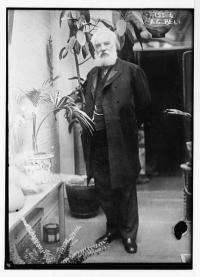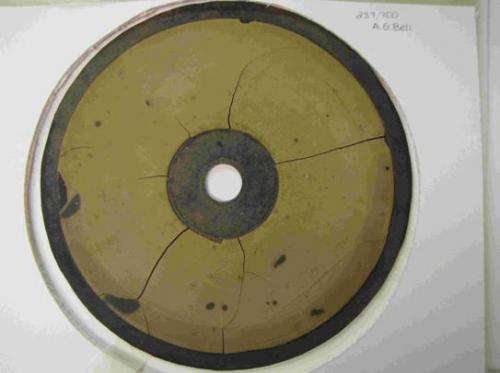December 28, 2011 weblog
Team uses high-tech optical technique to pull sound from 125 year old recordings

(PhysOrg.com) -- Scientists from Lawrence Berkeley National Laboratory have succeeded in using 3D optical scanning technology to effectively lift the voices from 125 year old recordings created by researchers working in Alexander Graham Bell’s Volta laboratory. The recordings were made on various media as researchers tried to improve the sound quality of Thomas Edison’s recently invented phonograph.
Bell, made famous by his invention of the telephone, was working with a team of researchers in his Volta laboratory in the 1880’s in Washington D.C. and as a precaution against having his ideas stolen by competing teams, periodically sent samples of the results of his and his team’s efforts to the Smithsonian Institute, also in Washington, for safe-keeping. Unfortunately, devices to play the recordings were not sent along as well, which meant the recordings sat unheard in storage for a century and a quarter.
Now however, thanks to a special optical scanning technique, those voices can once again be heard. Restoration specialists Carl Haber and Earl Cornell working with digital conversion specialists and museum curators, used a hardware/software system called IRENE/3D, to first take high resolution images of the spinning discs and then to remove errors introduced by damage to the discs or cylinders. They then finished by mimicking a stylus as it moved over the media, on a computer, reproducing the originally recorded voices. Using such a system, the early recordings can be played without anything actually touching the original media, which could conceivably be damaged in the process.

Using the technique, the team was able to hear human voices reciting Shakespeare, or reading from a book or newspaper. It’s not known if any of the voices heard is actually Bell, but historians believe Volta Laboratory only had three inventors: Bell, Bell’s cousin Chichester and Charles Sumner Tainter. Thus it seems possible that one or more of the voices is his.
An example of an extracted audio file.
Another attractive feature of the IRENE/3D system, which was developed at Berkley nearly a decade ago, is that it is able to scan discs made of various materials. In the case of the discs from the Smithsonian, some were made of wax, others of glass, with would have required developing unique individual players if each was to be actually played to hear what was on it.
Thus far the team has succeeded in reproducing the recordings on six discs, but have many more to work with as the Smithsonian has some 400 such discs and cylinders from Volta Laboratory and several others.
More information: bio16p.lbl.gov/
© 2011 PhysOrg.com




















